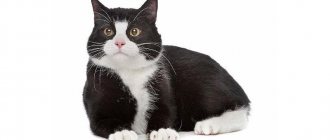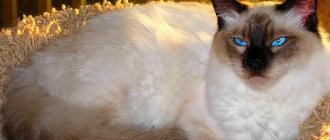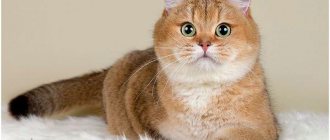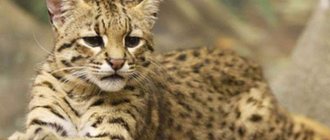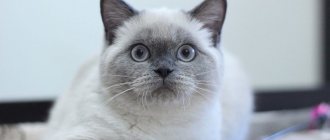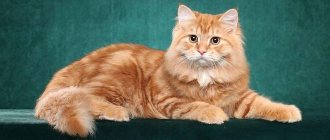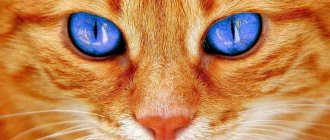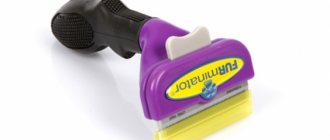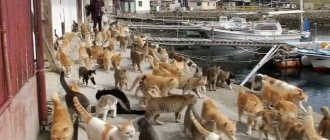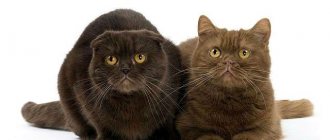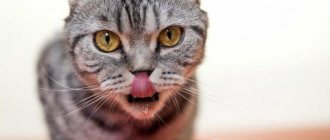9 breeds of spotted cats for those who want to have a pet leopard
Leopard-colored cats attract animal lovers not only with their exotic appearance. We will tell you in more detail about the whims and behavioral characteristics of these amazing pets.
- 2 Toyger
- 3 Savannah
- 4 Serengeti
- 5 Ocicat
- 6 Egyptian Mau
- 7 Pixiebob
- 8 Australian Smoke
- 9 California Shining Cat
The most popular hybrid spotted cat breeds
Most of these are animals obtained by crossing with wild cats.
Bengal
A hybrid of the Asian Leopard Cat or Lesser Leopard (ALC) and a domestic cat, bred by American breeder Jean Mill. Selection work began in 1961. Today the breed is recognized by all felinological systems of the world. The animal has been a pet since the fourth generation.
The first individuals were exclusively “golden” in color - there were black spots on a red background. With the development of the breed, pets of different colors were obtained:
- silver - the main background is silver;
- snow - in three modifications - linx, mink and sepia;
- marble - the spots merge into a large “cloak” or “sparble” pattern;
- charcoal - on a black background there are marks of the same color, while this is an experimental color.
Today, especially popular are individuals whose spots on the skin are arranged in the form of “rosettes”, reminiscent of the pattern of a jaguar’s fur. The most valuable pattern consists of three colors.
Even Bengals of the Siamese-Himalayan type have been bred. But no matter the color, the coat is the main distinguishing feature of this breed. It must have a “wild” pattern and is of the highest quality - short, without undercoat, tightly adjacent to the muscular body, glittery.
A kitten experiences phasing at two to five months, a process characteristic of wild cats. The bright pattern is hidden under the long secondary hair. The baby “blooms” to the age when his physical development allows him to protect himself from enemies and obtain food, in full accordance with natural canons.
Excessive hair loss occurs only during this period of time; in adult life, the Bengal cat does not shed.
This charming animal is rightfully called the “domestic leopard” due to its exceptional exotic coat pattern and energetic temperament.
Toyger
This is a “defective” Bengal, in which the standard prohibits the merging of spots into stripes.
The genetic fixation of this deficiency helped the emergence of a new breed. It was created by Judy Sugden, daughter of Jean Mill. Not all felinological systems have yet received recognition.
The colors of the Toyger are the same as those of the Bengal cat.
Savannah
The largest modern cat breed. It is a hybrid of Serval and Abyssinian. Registered by breeder Patrick Kelly in 2001 in the American felinological system TICA.
Savannah got the leopard coloring from a wild ancestor. Its color varieties are gold, silver, brown (ed), chocolate, cinnamon.
By nature, these cats are very curious and intelligent, easy to train. They do not tolerate loneliness well. Active, jumping and busy pets need a lot of space to play and love water very much.
Serengeti
A hybrid of Bengal and Oriental was created in California in 1994 by breeder Karen Sauzman. Due to its close resemblance to the Bengal cat, the breed is not widespread. Registered only in the American TICA system.
Diet
By providing your leopard-colored cat with proper care and, most importantly, a balanced diet, you can enjoy her presence for more than 15 years.
The Bengal diet mainly consists of protein foods:
- Meat – dietary beef, lamb, chicken fillet. Their. It is better to give it to your pet in pieces and raw. The meat must be frozen first to kill parasites.
- By-products – liver, udder, chicken heart.
- Sea fish. Bengals can be fed small fish without removing the bones. With a large one, they should be removed. Not all Bengalis love seafood. If they don’t want it, then don’t give it to them – they have enough meat.
- Fermented milk - low-fat cottage cheese, kefir and sour cream.
- Boiled, or soft-boiled, eggs – pamper your mustachioed one with them 2-3 times a week. Can be mixed with cereals.
- Boiled vegetables and root vegetables are mixed with protein foods.
In the initial stages, find out your pet’s preferences and plan a diet based on his desires. Another option is a good commercial premium food.
The most popular spotted breeds of domestic cats
The tabby color is also found in breeds bred without crossing with wild cats.
Ocicat
In appearance it resembles the brightest cat in the world, Ocelot, and got its name in honor of him. Although it has no relationship with a wild cat, but was obtained by crossing a Siamese and Siamese-Abyssinian mestizos.
By its temperament, the Ocicat is a cheerful and playful pet, loyal and affectionate, sociable and loving.
The colors vary in color, but always with spots.
Egyptian Mau
Descended from common street cats of Cairo. Exported to America in the fifties of the last century. One of the oldest natural breeds in the world.
The color of the short, dense coat can be different - silver, bronze, smoky, pewter. But always a tabby - and only a dark spot.
A distinctive feature of his appearance is the “scarab” mark on his forehead and the black “eyeliner” of his expressive green eyes.
This small, muscular and very active cat has a balanced and independent character. She is attached to people, does not like loneliness, and is friends with all pets. Loves to talk with family members. The sounds that the Mau makes are not always like meowing, but resemble the “mumbling” of a person.
And you can learn more about this cat by reading the article about the Egyptian Mau on our portal.
Pixiebob
The Elf with the Short Tail was developed in the United States in 1985. The exact origin of the breed has not been determined; there is a version that wild cats participated in the selection, but this has not been confirmed by anything.
The pixie bob is characterized by the appearance of a lynx with tufted ears and a short tail. Polydactylism is common. The short or semi-long coat is always tabby in color - with spots or “rosettes”.
In their devotion to humans, these cats resemble dogs. Very calm, attentive and observant pets are friendly and love to play with children. They swim excellently, climb trees, hunt, “talk”, making beautiful curling and chirping sounds. They get along well with other pets, but are always leaders.
British Shorthair and Scottish Fold cats
The British and Scottish Fold are essentially different types of the same breed, although they are registered separately in feline systems. These are some of the most popular and oldest domestic breeds in the world.
By nature, these pets are self-sufficient, almost always phlegmatic. They like to sleep, but are not fans of active pastime. They are attached to people, love and do not offend children. Unpretentious and calm.
The colors of these cats are varied, spotted colors are very common.
American Shorthair (Kurzhaar)
This breed developed from its European relatives, who migrated with humans to America. A group of breeders began working on the approval of the variety at the beginning of the twentieth century.
The most famous color is the silver tabby - bright black, rather large spots on a light gray background.
The character of the American is called the “golden mean”, the cat is calm, does not require constant human attention, is moderately active and very devoted to the owner and all household members.
European Shorthair
The spotted color of this oldest breed is widely popular. The oldest European native variety was registered and presented to the public only in 1982.
A kind, energetic animal is deeply devoted to humans, willingly plays with children and at the same time never loses its hunting instincts.
Siberian
This natural oldest Russian breed most likely descended from Oriental cats brought to Siberia by merchants.
Animals with long hair and a thick undercoat are excellent hunters and have an independent and calm character. They are sincerely devoted to the owner and all household members, but do not like attention and affection imposed on them.
Among the many colors of Siberians, tabby is common.
Maine Coon
The raccoon cat is the pride of Americans. This natural breed has long been in the lead as the largest. The size of an adult cat (length with tail) reaches one and a half meters and weighs sixteen kilograms.
This pet is calm and undemanding, friendly and devoted to humans. But at the same time, like its ancient wild ancestor, it is an excellent hunter.
The colors of the coon are varied, spotted is quite popular.
Conditions of keeping: how to arrange a comfortable stay for a Bengal cat in the house
Household items that are truly vital for Bengal cats include:
- separate bowls for food and water;
- a lounger-bedding or a box - a house, you can use a spacious basket;
- a toilet in the form of an open tray or a closed structure, with filler in it (it happens that a cat does not go to the tray, preferring the toilet);
- toys in a wide range of sets - sticks, balls, artificial rodents, a running wheel, ideally a play complex is desirable, various houses - Bengals have an increased need for active games;
- scratching posts preferably of two types - with hard and soft structures (wood, cork, rope, bark).
Also, from time to time a special carrying box or bag for transportation is required.
Special devices
Scratching posts help save the decor and interior of the house from the claws of domestic predators. Even if the pet is walking outside, in the apartment he will sharpen his claws several times a day
When choosing an accessory, pay attention to:
— stability, structural strength;
— quality of materials, functionality;
— a height sufficient for an adult animal: a Bengal cat actively stretches its body to grasp with its claws.
What types of harnesses and collars are there?
Collars are purchased for different purposes - therapeutic and prophylactic and for walking, decorative for aesthetic purposes, and informational - so that a lost animal finds its home again. Nowadays special harnesses are produced for walking.
Walking harnesses are leashes of a special design that are preferable to a collar due to their safety for the animal. The cat's neck will not slip out of such a leash, and the danger of getting caught on anything is eliminated. Various designs distribute the load and do not put pressure on the pet's throat. Walking harnesses are:
— V-shaped, when the connecting bar of the loops falls on the cat’s chest;
- H-shaped, in which the bar rests on the back;
- in the form of two loops connected by a figure eight;
- in the form of a vest - such designs also allow you to protect the cat’s fur coat from dust, precipitation and dirt in some places.
Owners can choose soft leather, light cotton, durable, practical nylon harnesses.
Choosing a collar
The range of cat collars is even more diverse. For safety, they can be equipped with either stretchable inserts made of elastic materials, or special fasteners that operate under increased load and prevent suffocation of an animal hanging on a fence or branch. According to their intended purpose, these cat accessories are produced:
- to prevent flea infestation and ticks on the skin - these are impregnated by manufacturers with chemical compounds and can either destroy insects or act on larval eggs, interrupting their life cycle;
— for the purpose of identifying a lost animal (addressed products with a medallion or information written on the strip itself);
- for returning home independently from a walk - a built-in magnet opens the door;
- to give the animal a glamorous or shocking look - such collars satisfy the ambitions of the owners, but the cat itself is not needed.
Chips are now widely used, usually implanted under the cat's skin or attached to the ear. Sound, reflective, animal calming and even GPS collars are available that will allow the owner to monitor the pet’s movements.
The breed of domestic and wild leopard cats combines predatory grace with an accommodating, albeit independent character. With proper care, decent maintenance, and attentive attention, a Bengal cat will delight its owners for a long time with its appearance, good disposition, and decent manners of a well-bred pet.
The rarest spotted cats
Leopard-colored cats are also among the new experimental breeds that have not yet found recognition.
Australian Smoke (Mist)
Breeder Labor Street from Sydney carried out enormous selection work, which involved simple and purebred cats - Abyssinian, Siamese, Burmese. Among the many colors, tabby is one of the most common.
Mist inherited excellent health from the barn cats, and extraordinary grace and dignity from the elite. Gets along well with any pet, is devoted to people, loves children, is active and energetic. Approved by a limited number of felinological organizations, it is not widely distributed.
California radiant
Despite its wild appearance, this is not a hybrid breed, but a mixture of many varieties of cats - British Shorthair, Manx, Siamese, Angora, Abyssinian.
Created by American screenwriter Paul Casey as a symbol of wild African cats, mercilessly destroyed by humans.
Very smart, friendly, silent and undemanding pets are still very rare and are registered only in the TICA felinological system (USA).
Character and lifestyle of the forest cat
Wild forest cat
- a creature that prefers solitude. And each of these animals in the wild tries to occupy and defend its territory, often showing belligerence.
In the photo there is a wild forest cat
Typically, the areas they inhabit are about 1-2 hectares, and their boundaries are marked with an odorous secretion. The animals are shy and cautious, therefore, as a rule, they prefer not to get involved with people and avoid their settlements.
Wild cats lead an active nocturnal life, and only come out to hunt when it is dusk before sunset or early in the morning at dawn. They attack their victims with one jump, which can be up to 3 meters in length.
But in case of failure, the failed prey is usually not pursued. Wild cats have excellent hearing to hunt, but their vision and sense of smell are much less developed.
Animals do not like slush, and on cloudy days they prefer to hole up in their den, for which they usually choose tree hollows located at low altitudes in the forest, or find abandoned holes and nests, often using them simply to hide from sudden danger.
Pictured is an Amur forest cat
Settled in the mountains, they often find homes in rock crevices. Their temporary shelters can be shelters in dense tangles of branches or recesses under cliffs. Wild cats are excellent runners, able to quickly escape from any pursuer, and also hide from enemies by deftly climbing to the top of a tree.
Despite their caution, these animals often settled next to people, which brought mutual benefits to both animals and humans. A striking example of this is the Norwegian forest cat. – one of the most beloved and famous breeds in Northern Europe
– one of the most beloved and famous breeds in Northern Europe.
These hardy and strong animals are not only skillful and dexterous hunters, but also from ancient times served people as gentle pets, skillful exterminators of rats and mice - carriers of infections and eaters of food.
Pictured is a Norwegian forest cat
It is believed that the breed of Norwegian cats was brought to Scandinavia in the 9th century on the ships of the Vikings - skilled navigators who firmly believed that these animals were none other than the descendants of the cats that drove the chariot of the goddess Freya across the firmament, adopting from their owner the characteristics characteristic of her , a tender heart, as well as a stern and warlike, but fair essence.
Norwegian wild cats, having settled throughout Europe, gradually became more domestic, led lives near human settlements, but at the same time maintained their own independence and did not rely on human handouts.
Buy a forest cat
Nowadays, it is possible in specialized nurseries; amateur breeders also do this. The golden soft fur of these creatures, their emerald eyes and the ability to get along well with children make many animal lovers want to give such a pet a home.
Forest cat price
can be very different, and on average ranges from 10 to 50 thousand rubles. It all depends on the purebred, coat color and other characteristics.
And those purchasing such pets should know that it is best to adopt kittens at three months of age, carefully checking documents, looking at photographs of parents and information about vaccinations.
Wild spotted cats - pets
Wild leopard cats are very beautiful. The fashion for keeping them at home has arisen more than once in the human community. But not all representatives of the cat world can be safely placed in a house.
Today, only three spotted species are most widespread as pets.
Serval
The African bush cat is a medium cat. Body length with a short tail is up to one and a half meters, weight - up to twenty kilograms. A small head, long legs and high-standing large ears make this animal look like a cheetah.
In order for a Serval to grow up tame, it must be taken away from its mother in the first days of life and fed by hand. Therefore, you should only purchase such a pet from experienced breeders.
A properly raised kitten will grow into a friendly cat, but its wild roots must not be forgotten. An adult must have a separate enclosure.
Food: raw meat only. During growing up, great attention should be paid to ensuring that there is enough calcium in the diet. Children have fragile limbs and fractures often occur.
The Serval's coloring is magnificent - dark spots on a reddish background.
Read more photos and interesting information about the serval in a separate article on Mister Cat.
Ocelot
A very bright animal, resembling a leopard in appearance, although smaller in size.
Less accommodating and less trainable than the Serval. An adult should only be kept in an enclosure. Nevertheless, it is often found today in home keeping because of the extraordinary beauty of its amazing colors. Such a pet named Babao lived with the famous artist Salvador Dali.
Geoffroy's cat
This small wild animal is similar in size to its domestic counterpart.
The brightly spotted skin was highly valued in the fur industry. Today this species is on the verge of extinction and is protected by the CITES Convention.
Therefore, it is now rarely found in home keeping, although it is popular. It is well tamed if at an early age the pet was taken from its mother and raised in the hands of a person. There are only a few breeders of this species, and it is difficult to acquire such a cat.
Expert advice
Experts and experienced Bengal breeders advise buying a kitten only from a trusted nursery.
It is important to check the pedigree documents of the future pet. A Bengal with sore eyes, who is aggressive, scratches and often sneezes should not be adopted
The color of babies may not match that of an adult. A few months later he gains his contract and bright tone.
Elderly and calm people, as well as families with an infant, are better off not buying such an active breed. The sexual activity of male cats is addressed by spaying and neutering to prevent them from marking territory and singing their songs at night.
Some representatives of the breed can be overly jealous and selfish in nature. They do not tolerate dogs or other cats in the house, although as a leader they can get along with other furry household members from an early age.
Cats of this breed protect their territory and distinguish strangers from household members. They are not given to uninvited guests.
Serengeti
The Serengeti cat has the following characteristics: large ears, long legs, spotted body color and honey-colored fur around the eyes. Males are usually larger (up to 15 kg) with females weighing up to 12 kg. The behavior is more playful than with the habits of a hunter, curious, and the breed is also talkative.
The Serengeti can make a wide variety of sounds. They are characterized by dexterity and courage. For example, they attack dogs rather than hide from them. They also climb to any heights, fulfilling their curiosity, and are sociable on walks.
When breeding this breed (in America), the goal was to resemble the Serval. The Serengeti was obtained by crossing several breeds, including Bengal, Abyssinian and others. The experiment continues until now until an analogy of the serval without the admixture of its blood is derived.
Who are Bengal pussies suitable for?
Despite the increased popularity of pet leopards, these pets are not suitable for everyone. Good reviews about Bengal cats can be read on forums, mainly from experienced owners. Pussies with such a character are not suitable for people who love peace and quiet, since in this case the pet will require a lot of attention. Bengals are actively purchased by allergy sufferers, since the presence of a pet leopard in the apartment reduces the likelihood of allergic attacks.
